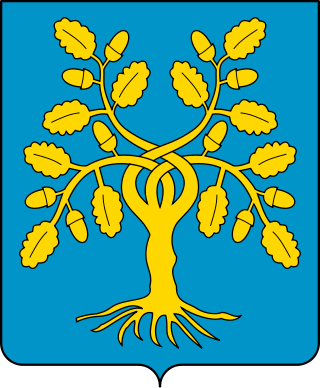
The House of Della Rovere was a powerful Italian noble family. It had humble origins in Savona, in Liguria, and acquired power and influence through nepotism and ambitious marriages arranged by two Della Rovere popes: Francesco Della Rovere, who ruled as Sixtus IV from 1471 to 1484 and his nephew Giuliano, who became Julius II in 1503. Sixtus IV built the Sistine Chapel, which was named after him. Julius II was patron to Michelangelo, Raphael and many other Renaissance artists and started the modern rebuilt of St. Peter's Basilica. Also the Basilica of San Pietro in Vincoli in Rome was the family church of the Della Rovere. Members of the family were influential in the Church of Rome, and as dukes of Urbino, dukes of Sora and lords of Senigallia; the title of Urbino was extinguished with the death of Francesco Maria II in 1631, and the family died out with the death of his granddaughter Vittoria, Grand Duchess of Tuscany.

The House of Orsini is an Italian noble family that was one of the most influential princely families in medieval Italy and Renaissance Rome. Members of the Orsini family include five popes: Stephen II (752–757), Paul I (757–767), Celestine III (1191–1198), Nicholas III (1277–1280), and Benedict XIII (1724–1730). The family also included 34 cardinals, numerous condottieri, and other significant political and religious figures. The Orsini are part of the Black nobility who were Roman aristocratic families who supported the Popes in the governance of the Papal States.

The dean of the College of Cardinals presides over the College of Cardinals in the Catholic Church, serving as primus inter pares. The position was established in the 12th century. He always holds the rank of a cardinal bishop, and is assisted by a vice-dean. Both are elected by and from the cardinal bishops who are not Eastern Catholic patriarchs, with their election subject to papal confirmation. Except for presiding over the college, the dean and vice-dean have no power over the other cardinals. In the order of precedence in the Catholic Church, the dean and vice-dean, as the two most senior cardinals, are placed second and third, respectively, after the pope.

John of Gravina, also known as John of Anjou, was Count of Gravina 1315–1336, Prince of Achaea 1318–1332, Duke of Durazzo 1332–1336 and ruler of the Kingdom of Albania. He was the youngest son of King Charles II of Naples and Mary of Hungary.

Gravina in Puglia is a town and comune of the Metropolitan City of Bari, Apulia, southern Italy.
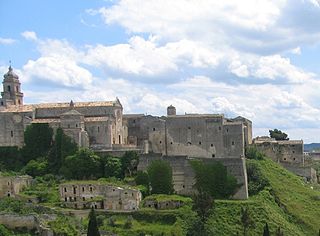
The diocese of Gravina and Montepeloso is a former ecclesiastical territory of the Roman Catholic Church in Apulia, southern Italy. Gravina is about 59 km (36 mi) southwest of Bari. Since 1986 it has formed part of the merged diocese of Altamura-Gravina-Acquaviva. Gravina in Apulia was the seat of the episcopal see from the ninth century.
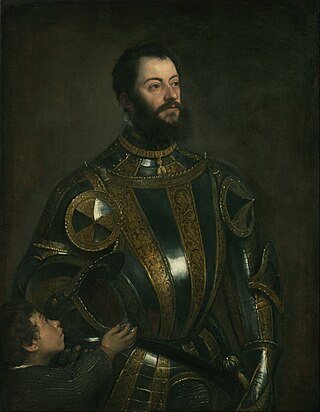
Alfonso d'Avalos d'Aquino, 6th Marquis of Pescara, 2nd Marquis of Vasto, was an Italian condottiero of Aragonese origins, renowned for his service in favour of Charles V, Holy Roman Emperor and King of Spain.

The Archdiocese of Naples is a Latin archdiocese of the Catholic Church in southern Italy, the see being in Naples. A Christian community was founded there in the 1st century AD and the diocese of Naples was raised to the level of an Archdiocese in the 10th century. Two Archbishops of Naples have been elected Pope, Paul IV and Innocent XII.
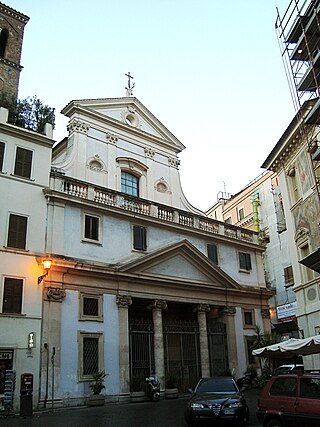
Sant'Eustachio is a Roman Catholic titular church and minor basilica in Rome, named for the martyr Saint Eustace. It is located on Via di Sant'Eustachio in the rione Sant'Eustachio, a block west of the Pantheon and via della Rotonda, and a block east of Sant'Ivo alla Sapienza and the Via della Dogana Vecchia.

The Diocese of Frascati is a Latin suburbicarian see of the Diocese of Rome and a diocese of the Catholic Church in Italy, based at Frascati, near Rome. The bishop of Frascati is a Cardinal Bishop; from the Latin name of the area, the bishop has also been called Bishop of Tusculum. Tusculum was destroyed in 1191. The bishopric moved from Tusculum to Frascati, a nearby town which is first mentioned in the pontificate of Pope Leo IV. Until 1962, the Cardinal-Bishop was concurrently the diocesan bishop of the see. Pope John XXIII removed the Cardinal Bishops from any actual responsibility in their suburbicarian dioceses and made the title purely honorific.

The Archdiocese of Perugia-Città della Pieve is a Latin archdiocese of the Catholic Church. It was historically the Diocese of Perugia. It became the Archdiocese of Perugia in 1882, but without suffragans. It acquired suffragan dioceses in 1972. It was united in 1986 with the Diocese of Città della Pieve.

The Diocese of Tivoli is a Latin Church ecclesiastical territory or diocese of the Catholic Church in Latium, Italy, which has existed since the 2nd century. In 2002 territory was added to it from the Territorial Abbey of Subiaco. The diocese is immediately exempt to the Holy See.

The Diocese of Conversano-Monopoli is a Latin diocese of the Catholic Church in Apulia. It has existed since 1986, when the diocese of Monopoli was united with the historic diocese of Conversano. The diocese is a suffragan of the Archdiocese of Bari-Bitonto.

Don Francesco Maria Marescotti, Principe Ruspoli was the 6th Count of Vignanello and Parrano and 1st Prince of Cerveteri.

The Castle of Muro Lucano is a castle in the commune of Muro Lucano in the Potenza province of the Basilicata region of southern Italy. It was originally built in the 9th century and parts of it are still inhabited by the Martuscelli family, relatives of Francesco Domenico Lordi who bought the castle in 1830.
Costanzo Zani, O.S.B. (1622–1694) was a Roman Catholic prelate who served as Bishop of Imola (1672–1694).
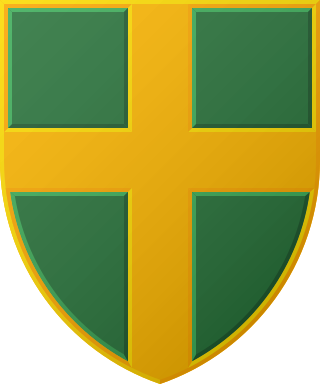
The following is a list of all 422 of the Chief Executives of Pula ordered by the dates of their mayoral terms which are put in parentheses.

Gian Giordano Orsini, IV Lord of Bracciano was an Italian nobleman and condottiero. He married Felice della Rovere and was the son-in-law of Pope Julius II.















